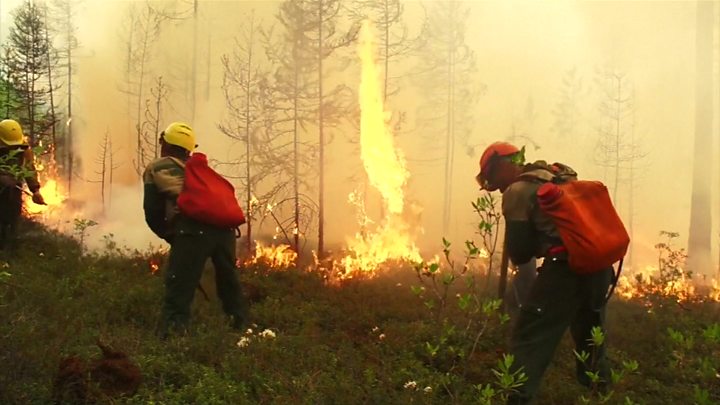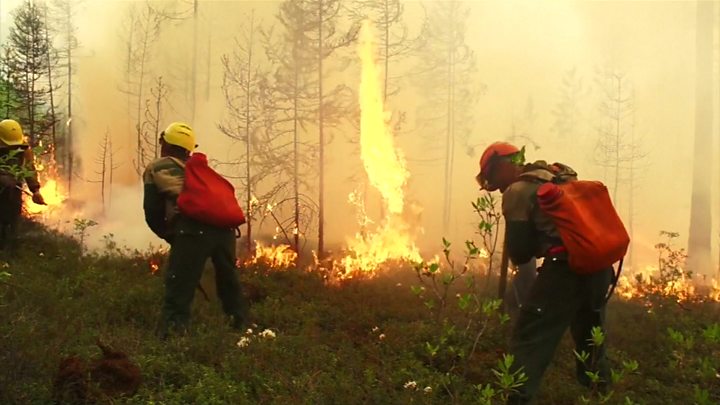Arctic wildfires: What’s caused huge swathes of flames to spread?


Media playback is unsupported on your device
Wildfires are ravaging the Arctic, with areas of northern Siberia, northern Scandinavia, Alaska and Greenland engulfed in flames.
Lightning frequently triggers fires in the region but this year they have been worsened by summer temperatures that are higher than average because of climate change.
Plumes of smoke from the fires can be seen from space.
Mark Parrington, a wildfires expert at the Copernicus Atmosphere Monitoring Service (Cams), described them as “unprecedented”.
How bad is it?
There are hundreds of fires covering mostly uninhabited regions across eastern Russia, northern Scandinavia, Greenland and Alaska.
But smoke is affecting wider surrounding areas, engulfing some places completely.
Cities in eastern Russia have noted a significant decrease in air quality since the fires started.
The smoke has reportedly reached Russia’s Tyumen region in western Siberia, six time zones away from the fires on the east coast.
In June, the fires released an estimated 50 megatonnes of carbon dioxide – the equivalent of Sweden’s annual carbon output, according to Cams.
How unusual is this?
Arctic fires are common between May and October and wildfires are a natural part of an ecosystem, offering some benefits for the environment, according to the Alaska Centers website.
But the intensity of these fires, as well as the large area they have taken up, make these unusual.
“It is unusual to see fires of this scale and duration at such high latitudes in June,” said Mr Parrington.
“But temperatures in the Arctic have been increasing at a much faster rate than the global average, and warmer conditions encourage fires to grow and persist once they have been ignited.”
Extremely dry ground and hotter than average temperatures, combined with heat lightning and strong winds, have caused the fires to spread aggressively.
The burning has been sustained by the forest ground, which consists of exposed, thawed, dried peat – a substance with high carbon content.
Dangerous amplification
Global satellites are now tracking a swathe of new and ongoing wildfires within the Arctic Circle. The conditions were laid in June, the hottest June for the planet yet observed in the instrumented era.
The fires are releasing copious volumes of previously stored carbon dioxide and methane – carbon stocks that have in some cases been held in the ground for thousands of years.
Scientists say what we’re seeing is evidence of the kind of feedbacks we should expect in a warmer world, where increased concentrations of greenhouse gases drive more warming, which then begets the conditions that release yet more carbon into the atmosphere.
A lot of the particulate matter from these fires will eventually come to settle on ice surfaces further north, darkening them and thus accelerating melting.
It’s all part of a process of amplification.
What is being done to tackle the fires?
Russian authorities are not tackling the majority of the fires as they argue the cost would be bigger than the damage caused by the flames.
“They do not threaten any settlements or the economy,” the press service of the Krasnoyarsk Region forestry ministry told a Siberian news website.
The hashtags #putouttheSiberianfires and #saveSiberianforests are currently trending on Twitter as Russians complain the government is not doing enough to tackle the crisis.
Some argue that the Notre Dame fire in Paris received far more media attention than the forest fires.
“Remember how far the news about the Notre Dame fire spread? Now is the time to do the same about the Siberian forest fires,” said one tweet.
Another said: “Let’s not forget that nature is no less important than history. Numerous animals have lost their homes, and many of them are probably dead. Just thinking about this is painful.”
Alaska Centers agree that “fire-suppression efforts sometimes are more damaging than the wildfire”.


